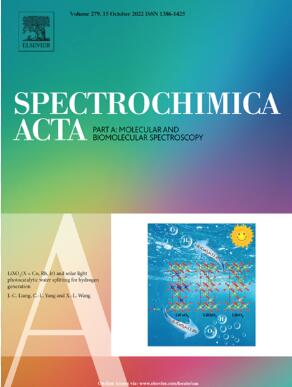A portable sensing platform using a novel dipyrrolopyrazinedione-based aza-BODIPY dimer for highly efficient detection of hypochlorite and hydrazine
IF 4.3
2区 化学
Q1 SPECTROSCOPY
Spectrochimica Acta Part A: Molecular and Biomolecular Spectroscopy
Pub Date : 2025-05-21
DOI:10.1016/j.saa.2025.126415
引用次数: 0
Abstract
As widely used chemical reagents in different industrial fields, reactive hydrazine (N2H4) and hypochlorite (ClO−) show significant risks to human health, drink water, and environment. Currently, fluorescence detection of two analytes suffers from slow and minor spectral change, high detection limit and poor selectivity. In this work, by introducing electron deficient 1,4-pyrazine ring enhanced chromophore reaction strategy, a novel dipyrrolopyrazinedione-based aza-BODIPY dimer (PzDP-PPAB) was synthesized for the first time. Interestingly, PzDP-PPAB for dual-responsive detection of N2H4 and ClO− has been developed, accompanying with large spectral change (Δλab = 250 nm for N2H4 and Δλab = 277 nm for ClO−), distinctly dual colorimetric/fluorescent turn-on responses, low detection limits (N2H4: 40 nM; ClO−: 59 nM) and good selectivity. The sensing mechanism reveals that PzDP-PPAB chromophore as a novel recognition site is selectively disrupted by N2H4 and ClO−, where two different less conjugated products with diverse outputs were displayed. More importantly, PzDP-PPAB has been effectively utilized for detecting ClO− in both water and vegetables samples with excellent recovery rate. The portable sensing platforms based on silica gel or sponge loaded with PzDP-PPAB provide a visual and convenient method for monitoring N2H4 in both solution and gaseous state. This work presents a promising fluorescent probe for monitoring N2H4 and ClO− with a novel sensing mechanism capable of efficient detection of two pollutants.
一种新型的基于双吡咯吡嗪二酮的aza-BODIPY二聚体的便携式检测平台,用于高效检测次氯酸盐和肼
活性肼(N2H4)和次氯酸盐(ClO -)作为广泛应用于不同工业领域的化学试剂,对人类健康、饮用水和环境具有重大风险。目前,两种分析物的荧光检测存在光谱变化慢、变化小、检出限高、选择性差等问题。本文通过引入缺电子1,4-吡嗪环增强发色团反应策略,首次合成了一种新型的二吡咯吡嗪二酮基aza-BODIPY二聚体(PzDP-PPAB)。有趣的是,用于N2H4和ClO−双响应检测的PzDP-PPAB已经开发出来,具有较大的光谱变化(N2H4为Δλab = 250 nm, ClO−为Δλab = 277 nm),明显的双比色/荧光开启响应,低检测限(N2H4: 40 nm;ClO−:59 nM),选择性好。传感机制表明,PzDP-PPAB发色团作为一种新的识别位点被N2H4和ClO−选择性地破坏,其中显示了两种不同的低共轭产物,输出不同。更重要的是,PzDP-PPAB可以有效地用于检测水和蔬菜样品中的ClO−,且回收率高。基于硅胶或海绵负载PzDP-PPAB的便携式传感平台提供了一种可视化和方便的方法来监测溶液和气态的N2H4。这项工作提出了一个有前途的荧光探针监测N2H4和ClO−具有新的传感机制,能够有效地检测两种污染物。
本文章由计算机程序翻译,如有差异,请以英文原文为准。
求助全文
约1分钟内获得全文
求助全文
来源期刊
CiteScore
8.40
自引率
11.40%
发文量
1364
审稿时长
40 days
期刊介绍:
Spectrochimica Acta, Part A: Molecular and Biomolecular Spectroscopy (SAA) is an interdisciplinary journal which spans from basic to applied aspects of optical spectroscopy in chemistry, medicine, biology, and materials science.
The journal publishes original scientific papers that feature high-quality spectroscopic data and analysis. From the broad range of optical spectroscopies, the emphasis is on electronic, vibrational or rotational spectra of molecules, rather than on spectroscopy based on magnetic moments.
Criteria for publication in SAA are novelty, uniqueness, and outstanding quality. Routine applications of spectroscopic techniques and computational methods are not appropriate.
Topics of particular interest of Spectrochimica Acta Part A include, but are not limited to:
Spectroscopy and dynamics of bioanalytical, biomedical, environmental, and atmospheric sciences,
Novel experimental techniques or instrumentation for molecular spectroscopy,
Novel theoretical and computational methods,
Novel applications in photochemistry and photobiology,
Novel interpretational approaches as well as advances in data analysis based on electronic or vibrational spectroscopy.

 求助内容:
求助内容: 应助结果提醒方式:
应助结果提醒方式:


